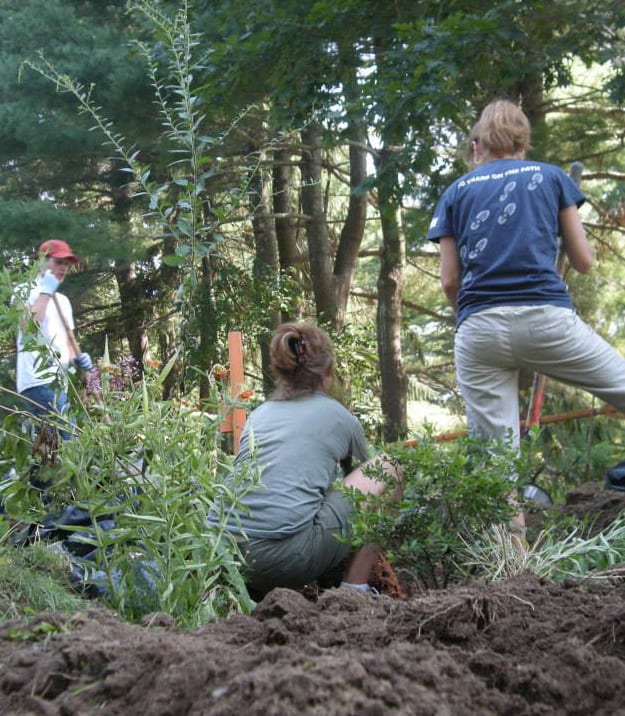Creating a Backyard Demonstration Area for People and Wildlife
by Rachel Stevens
Watch us “grow” as we develop a backyard wildlife gardening demonstration area on a conservation property along the shores of Great Bay, New Hampshire. Although still being created, the garden will showcase ideas to create a low maintenance and beautiful backyard that also provides shelter, food, and water for wildlife.
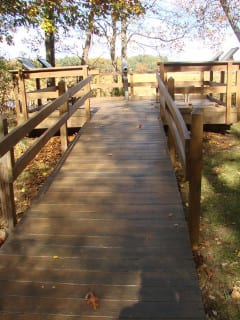
The property hosts a wildlife viewing platform that overlooks salt marsh and an osprey nest in which young have been raised successfully every year since 1993.
Owned by the New Hampshire Fish and Game Department and managed by Great Bay National Estuarine Research Reserve, the property designated for our garden had been partially developed sometime earlier. Once we removed the existing infrastructure, we were left with a large area of fill that was literally a blank slate on which new gardens could be created.
Education is an important part of this demonstration garden, both in achieving the end result and in its roots. The Reserve collaborated with University of New Hampshire Professor John Hart and his landscape design students to create the plan for the garden. After visiting the site and learning about our goals, each student created a design. Robbi Woodburn, principal landscape architectural designer at Woodburn & Company, volunteered her creative vision to select components from the students’ work and integrate them into an overall landscape master plan.
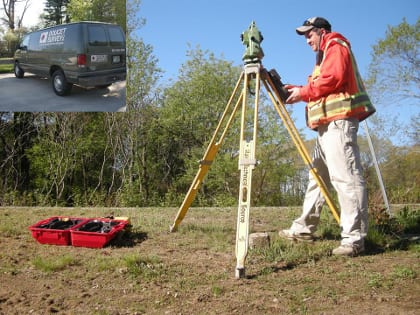
Several local companies have generously donated their professional services to the demonstration garden.
Community Collaboration
Community collaboration continued as creation of the gardens began. The garden project benefited from an array of participants:
- An Earth Day volunteer event removed invasive species
- Doucet Survey Inc and West Environmental donated their services to survey the site and delineated wetlands
- C G H Excavation and Chester Hollow Water Gardens created an amazing wildlife pond
- UNH students created fences and garden edging
- The Timberland Company donated materials and held several volunteer service days
- Site Structures was hired to do the hardscaping and to plant initial flower beds.
Funding has also been a collaborative effort. So far, funding has been provided by
- the Natural Resource Conservation Service
- NH Fish and Game Department
- NH Charitable foundation
- University of NH Master Gardeners.
Creation of the “Community Wildlife Garden” truly has been a community effort!
Inspired by Thoreau
In addition to the large pond, the property now hosts a wildlife viewing platform that overlooks salt marsh and an osprey nest in which young have been raised successfully each year since 1993. The tool shed has solar panels on the roof to provide electricity and gutters that drain into a water barrel and small rain garden. A hand pump has been installed to provide fresh water. A newly-built patio helps give the feeling of a true “backyard” and provides a place for people to rest.
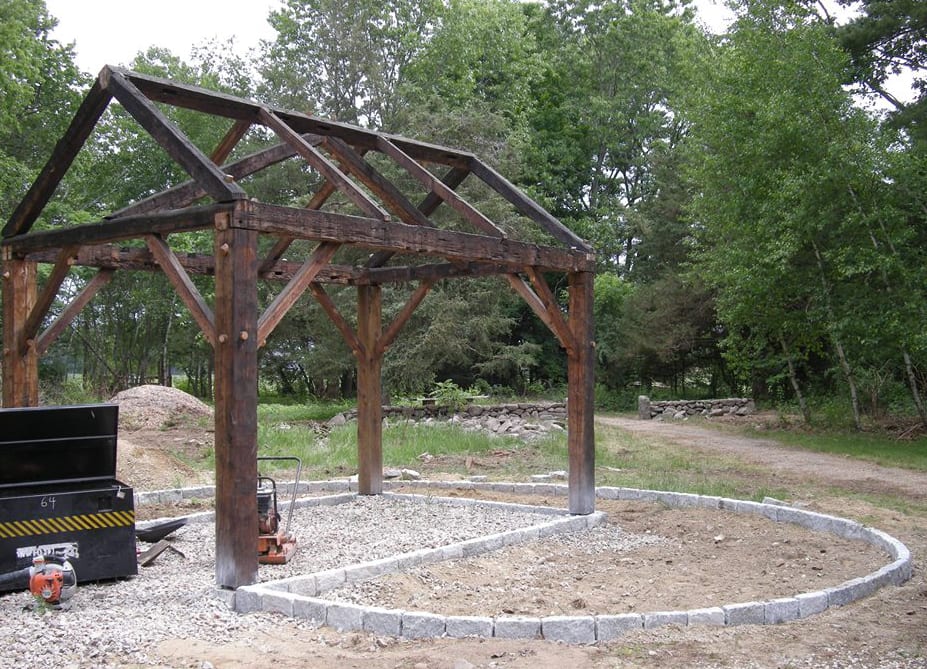
The site of the wildlife garden features an arbor of the same dimensions as Thoreau’s cabin. It is built from salvaged timbers, some of which are older than America itself!
A small dry stone wall provides hiding places for small mammals and a protected place for snakes to shed their skin. The garden is also now home to an arbor built with the same dimensions as Thoreau’s cabin. It is built from timbers salvaged from local historic houses, some of which are older than America itself. A local artist blacksmith has created representative windows, again the same size as those inThoreau’s cabin, and one window is open with a welded steel American robin “flying” in to perch on the sill.
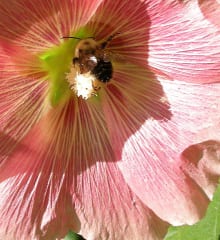 Around the arbor a “phenology” garden has been planted. Thoreau’s writings documented the timing of key seasonal changes in certain plant and animal events, such as flowering or migration. As climate changes, the timing of these occurrences may alter, and several classrooms and volunteer groups are documenting these changes under the umbrella of the National Phenology Network (www.usanpn.org). The robin is one of the species Thoreau wrote about, and now, over 150 years later, the robin is being monitored as part of the Phenology Network and changes in life cycle timing are being noted. Flowers such as lilac were planted in the phenology garden because their bloom date was observed by Thoreau and they are also being monitored as part of the Phenology Network.
Around the arbor a “phenology” garden has been planted. Thoreau’s writings documented the timing of key seasonal changes in certain plant and animal events, such as flowering or migration. As climate changes, the timing of these occurrences may alter, and several classrooms and volunteer groups are documenting these changes under the umbrella of the National Phenology Network (www.usanpn.org). The robin is one of the species Thoreau wrote about, and now, over 150 years later, the robin is being monitored as part of the Phenology Network and changes in life cycle timing are being noted. Flowers such as lilac were planted in the phenology garden because their bloom date was observed by Thoreau and they are also being monitored as part of the Phenology Network.
Variation on Themes
We have planted small shrubs to create a “living fence” and plan several other themed gardens. A “mast garden” of soft and hard mast, that is berries and nuts, has been begun and will provide food for wildlife such as turkeys and cedar waxwings. A wild flower meadow is being created around the viewing platform and a short path leads through a section of forest back into the main garden. There is a lot packed into a less than two acre site.

We still have work to do. We plan to install life sized metal sculptures that indicate the theme of each garden.
We still have plenty of work to do! We plan to install life sized metal sculptures that indicate the theme of each garden. We have ferns to plant in one section of forest that will allow a view to the salt marsh and water while still keeping tree canopy in place. We plan a sunflower garden and pollinator plot. The landscaping company we hired is in the process of creating a “no mow” lawn area this fall, and we hope to be ready for a ribbon-cutting opening event next Earth Day.
Although this is definitely a work in progress as we continue to grow, the property is open to the public and is a great place to stop and have a relaxing stroll. At this time of year the vivid reds of Salicornia species are striking as the autumn color of the salt marsh develops, and I have often seen majestic white flocks of migrating egrets feeding there too. We hope you have a chance to stop by, check our progress, and explore.
Directions to the Community Wildlife Garden
The property is located at 80 College Road in Stratham. Parking for the site is at Chapman’s Landing boat launch. From there, a short footpath leads to the site. Learn more about the project at www.facebook.com/GreatBayNerrCommunityWildlifeGarden.
About the Author
Rachel Stevens is the Stewardship Coordinator and Wildlife Ecologist at Great Bay National Estuarine Research Reserve, a State-Federal partnership between New Hampshire Fish and Game Department and the National Oceanic and Atmospheric Administration. For questions regarding this project, please contact Rachel at Rachel.stevens@wildlife.nh.gov.

